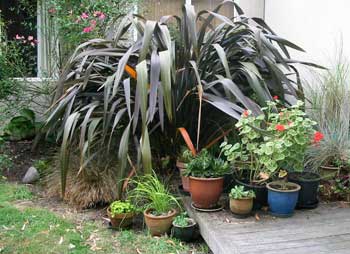Creating an Outdoor Room or a Small Garden Playground
Sometimes gardening isn’t limited by space, but by time and interest. If you love the idea of being surrounded by a garden, but you can’t see yourself spending countless hours with a pruner in your hands, a wonderful option is to create a garden paradise on your patio or terrace. You could still incorporate beds and containers, but you have the added element of hardscaping. They haven’t invented a stone yet that doesn’t look even better next to a plant. Even concrete looks chic. Building a patio or terrace is a major undertaking and not within my expertise. Many people would just as soon hire a professional for this job. About’s Landscaping Guide, David Beaulieu, has several excellent how tos for laying stone and brick. They’ll be very helpful for you do-it-yourselfers and I’ve provided links.
Once you have your terrace, planting it is the enjoyable part.
Here I’ll talk about framing, softening the edges, creating paths and maximizing your patio’s potential.

Planting a Patio or Terrace
The main purpose of a patio or terrace is to have a place to relax and entertain. Surrounding yourself with the beauty of plants will make it that much easier. Even non-gardeners now consider their patios an extension of their homes - a room without walls. Rather than just providing a view, interior design is carried from the inside out.
Framing
Creating a distinction between your patio or terrace and your lawn is how you turn this outdoor space into an outdoor room. You can accomplish this by outlining the patio with a border, by building raised planters around the edge or by creating an edge with containers.
Borders: Having a border around your terrace is enjoying the best of both worlds. You have a true garden to putter in and you never have to leave the comfort of your living area. The border will probably be somewhat narrow, 2-4 feet, but a lot can be accomplished in this space. In addition to plants that spill onto the patio, like lady’s mantle and geraniums, you can create clusters of height with grasses or small shrubs. If the border runs between the house and the patio, you might want to try your hand at espalier, or growing a fruit tree trained to lay flat against the house wall. The heat of the house and the openness of the branches produces a considerable yield in a small space.
Built-ins: Many patio designs have built-in flower boxes along the perimeter. They delineate the space and provide additional seating. But more importantly, they provide an eye level garden. You have all the advantages and control of container gardening as well as the root insulation provided by brick or stone. Many plants will do well in these circumstances, but it’s especially nice to have scented plants: roses, heliotrope, gardenias, jasmine and sweet peas.
Containers: If you don’t have an edge border or built-in boxes, you can always create the effect with containers. Either an entire row of matched containers, simulating built-ins, or clusters of different sizes and shapes, filled with a variety of plant material.
Any of these options will create a distinction between your living space and the openness of the rest of your property.

Softening Hard Edges
Stone is beautiful, but on its own it can look cold, hard and uninviting. Two types of plants will be especially useful in turning your patio or terrace into an welcoming retreat.
- Spillers: Plants that flow out onto the stone will automatically soften the hard edges. Light, airy foliage is especially good for this. Lady’s mantle (Alchemila mollis), Love-In-A-Mist (Nigella damascena), coreopsis, lavender and ferns are good examples. Just be sure to suit your plants to your sun exposure, because proximity to stone is going to intensify the heat.
- Creepers: Unless your patio or terrace is paved, there are bound to be spaces between your stones. You’ll learn soon enough that weeds will readily grow there. So why not use the spaces to grow something more attractive? Thyme, sedum, scotch moss and creeping jenny are often used for this purpose. Don’t try to fill every crack. Plants can become slippery when squished or wet and you should use care that heavy traffic areas are safe. But a few selected spots will give your terrace a touch of Tuscany and a well lived in feel. You’ll be surprised how quickly these plants will acclimate and find their own way around the patio.



0 comments:
Post a Comment